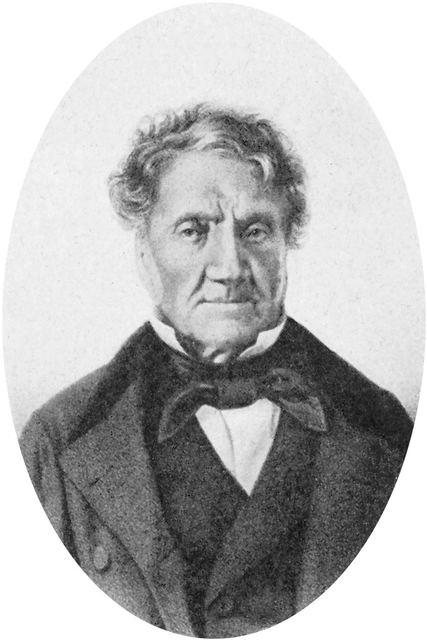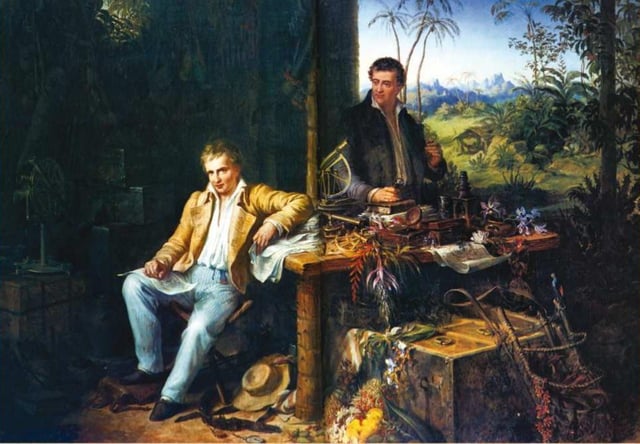Aimé Bonpland

Aimé Bonpland

Aimé Bonpland | |
|---|---|
| Born | August 1773 La Rochelle, France |
| Died | May 1858 (1858-06)(aged 84) Paso de los Libres, Argentina |
| Nationality | French |
| Alma mater | University of Paris |
| Known for | Travel with Alexander von Humboldt |
| Awards | French Academy of Sciences |
| Scientific career | |
| Fields | Physician, biologist, botanist, natural history |

Humboldt and Bonpland at the Chimborazo base

Humboldt and Bonpland in the Amazon rainforest
Aimé Jacques Alexandre Bonpland[1] (August 1773 – May 1858) was a French explorer and botanist who traveled with Alexander von Humboldt in Latin America from 1799 to 1804. He co-authored volumes of the scientific results of their expedition.
The standard author abbreviation Bonpl. is used to indicate this person as the author when citing a botanical name.[2]
Aimé Bonpland | |
|---|---|
| Born | August 1773 La Rochelle, France |
| Died | May 1858 (1858-06)(aged 84) Paso de los Libres, Argentina |
| Nationality | French |
| Alma mater | University of Paris |
| Known for | Travel with Alexander von Humboldt |
| Awards | French Academy of Sciences |
| Scientific career | |
| Fields | Physician, biologist, botanist, natural history |
Biography
Bonpland was born as Aimé Jacques Alexandre Goujaud[3] in La Rochelle, France, on 22,[4][1][3] 28,[5][6] or 29 August 1773. His father was a physician[7] and, around 1790, he joined his brother Michael in Paris, where they both studied medicine.[8] From 1791, they attended courses given at Paris's Botanical Museum of Natural History. Their teachers included Jean-Baptiste Lamarck, Antoine Laurent de Jussieu, and René Louiche Desfontaines;[8] Aimé further studied under Jean-Nicolas Corvisart[4] and may have attended classes given by Pierre-Joseph Desault at the Hôtel-Dieu. During this period, Aimé also befriended his fellow student, Marie François Xavier Bichat.
Amid the turmoil of the French Revolution and Revolutionary Wars, Bonpland served as a surgeon in the French army[1] or navy.[4][7][9][3]
Having befriended Alexander von Humboldt at Corvisart's house,[7] he joined him on a five-year journey through Mexico, Colombia, and the Orinoco and Amazon basins.[4] During this trip, he collected and classified about 6,000 plants that were mostly unknown in Europe up to that time.[4] His account of these findings was published as a series of volumes from 1808 to 1816 entitled Equatorial Plants (French: Plantes equinoxiales).[4]
Upon his return to Paris, Napoleon granted him a pension of 3000 francs per year in return for the many specimens he bestowed upon the Museum of Natural History.[7] The Empress Josephine was very fond of him and installed him as superintendent over the gardens at Malmaison,[4][7] where many seeds he had brought from the Americas were cultivated.[7] In 1813, he published his Description of the Rare Plants Cultivated at Malmaison and in Navarre (Description des plantes rares cultivées à Malmaison et à Navarre).[4] During this period, he also became acquainted with Gay-Lussac, Arago, and other eminent scientists and, after the abdication of Fontainebleau, vainly pleaded with Napoleon to retire to Mexico.[4][7] He was present at Josephine's deathbed.[7]
In 1816, he took various European plants to Buenos Aires, where he was elected professor of natural history.[4] He soon left his post, however, to explore the interior of South America.[4] In 1821, he established a colony at Santa Ana near the Paraná for the specific object of harvesting and selling yerba mate.[10] The colony was located in territory claimed by both Paraguay and Argentina; further, José Gaspar Rodríguez de Francia, governor of Paraguay, "feared that Bonpland's success in cultivating mate would interfere with his own attempt to monopolize that business."[11] The Paraguayans therefore destroyed the colony on December 8,1821, and Bonpland was arrested as a spy and detained at Santa Maria, Paraguay [12] until 1829.[4][13] During his captivity, he married and had several children.[14] He was given freedom of movement and acted as a physician for the local poor[4] and the military garrison.[9] At the same epoch, the Swiss naturalist Johann Rudolph Rengger also stayed in Paraguay: he was not allowed to cross the strictly guarded border, but was free to circulate pending the request of a special permit for each excursion.[15]
Bonpland was freed in 1829[7] and in 1831[4] returned to Argentina, where he settled at San Borja in Corrientes.[4] There, aged 58, he married a local woman and made a living farming and trading in yerba mate.[9][16] In 1853, he returned to Santa Ana, where he cultivated the orange trees he had introduced.[4] He received a 10 000-piastre estate from the Corrientes government in gratitude for his work in the province.[4] The small town around it is now known as "Bonpland" in his honor. A different small town in Misiones province just south of Santa Ana (Misiones) is also named Bonpland.
Legacy
Bonpland's biography was written by Adolphe Brunel.[17] A fictionalized account of his travels with Humboldt occurs in Daniel Kehlmann's Die Vermessung der Welt, translated by Carol Brown Janeway as Measuring the World: A Novel.
Bonpland Street in the ritzy Buenos Aires neighborhood of Palermo Hollywood lies among streets named after Charles Darwin, Robert FitzRoy, and Alexander von Humboldt. There is also a Bonpland Street in the city of Bahía Blanca, Argentina, in Caracas, Venezuela, and in Montevideo, Uruguay.
Many animals and plants are also named in his honor, including the squid Grimalditeuthis bonplandi and the orchid Ornithocephalus bonplandi.
The lunar crater Bonpland is named after him. Also Pico Bonpland in the Venezuelan Andes is named to his honor, although he never visited the Venezuelan Andes. A peak of over 2,300 m (7,500 ft) in New Zealand also bears his name. The mountain is near the head of Lake Wakatipu in the South Island.
Taxonomic descriptions
The following genera and species have been named or described by Aimé Bonpland.
Genera
Abolboda
Aegopogon
Alchornea
Angelonia
Ceroxylon
Elionurus
Eriope
Espeletia
Eudema
Exostema
Fulcaldea
Guardiola
Hypocalyptus
Isertia
Leucophyllum
Limnocharis
Machaonia
Matisia
Menodora
Pleopeltis
Retiniphyllum
Triglochin
Vauquelinia
Species
Acacia subulata
Alchornea castaneifolia
Arceuthobium vaginatum
Aristida divaricata
Arrabidaea chica
Astragalus geminiflorus
Banksia marginata
Brachyotum confertum
Bertholletia excelsa
Brugmansia suaveolens
Brunellia ovalifolia
Cavanillesia platanifolia
Centronia mutisii
Cephalanthus salicifolius
Ceroxylon alpinum
Chuquiraga jussieui
Claytonia perfoliata
Coriaria thymifolia
Dorstenia tenuis
Draba violacea
Eucalyptus diversifolia
Eudema nubigena
Eugenia albida
Huperzia crassa
Hydrocleys nymphoides
Iochroma fuchsioides
Ipomoea arborescens
Iresine diffusa
Jacksonia furcellata
Juniperus phoenicea
Lilaea scilloides
Limnobium laevigatum
Limnocharis flava
Ludwigia helminthorrhiza
Ludwigia sedioides
Maurandya antirrhiniflora
Melaleuca pallida
Miconia caelata
Miconia guayaquilensis
Miconia lacera
Miconia minutiflora
Miconia theaezans
Mimosa somnians
Monochaetum multiflorum
Passiflora arborea
Pinguicula moranensis
Prosopis laevigata
Prosopis pallida
Prumnopitys montana
Quararibea cordata
Quercus crassifolia
Quercus crassipes
Quercus depressa
Quercus diversifolia
Quercus humboldtii
Quercus mexicana
Quercus obtusata
Quercus xalapensis
Smilax havanensis
Stanhopea grandiflora
Stanhopea jenischiana
Styrax tomentosus
Symphoricarpos microphyllus
Symplocos coccinea
Tagetes zypaquirensis
Theobroma bicolor
Trichilia acuminata
Viola cheiranthifolia
Vitis tiliifolia
Zieria laevigata
Works
1805: Essai sur la géographie des plantes. Written with Alexander von Humboldt. von Humboldt, Alexander; Bonpland, Aimé (2009). Essay on the geography of plants. Translated by Sylvie Romanowski, with an Introduction by Stephen T. Jackson. University of Chicago Press. ISBN 9780226360669. OCLC 977369593 [35] . English translation from 2009.
1811:A collection of observations on zoology and comparative anatomy written with Alexander von Humboldt, Printing JH Stone, Paris. Digital version [36] at the website Gallica.
1813:Description of rare plants grown at Malmaison and Navarre by Aimé Bonpland. Printing P. The elder Didot, Paris. By Aimé Bonpland dedicated to the Empress Joséphine. Digital version [37] at the website Botanicus, and Digital version of the illustrations [38] at the website of the Bibliothèque interuniversitaire de santé (Interuniversity Library of Health).
1815:Nova plantarum genera and species written with Alexander von Humboldt and Karl Sigismund Kunth, Volume 1, Lutetiae Parisiorum, Paris. Digital version [39] at the website Botanicus.
1816:Monograph Melastomacées including all plants of this order including Rhexies, Volume 1, Paris.
1817:Nova plantarum genera and species written with Alexander von Humboldt and Karl Sigismund Kunth, Volume 2, Lutetiae Parisiorum, Paris. Digital version [40] at the website Botanicus.
1818:Nova plantarum genera and species written with Alexander von Humboldt and Karl Sigismund Kunth, Volume 3, Lutetiae Parisiorum, Paris. Digital version [41] at the website Botanicus.
1820:Nova plantarum genera and species written with Alexander von Humboldt and Karl Sigismund Kunth, Volume 4, Lutetiae Parisiorum, Paris. Digital version [42] at the website Botanicus.
1821:Nova plantarum genera and species written with Alexander von Humboldt and Karl Sigismund Kunth, Volume 5, Lutetiae Parisiorum, Paris. Digital version [43] at the website Botanicus.
1823:Nova plantarum genera and species written with Alexander von Humboldt and Karl Sigismund Kunth, Volume 6, Lutetiae Parisiorum, Paris. Digital version [44] at the website Botanicus.
1823:Monograph Melastomacées including all plants of this order including Rhexies, Volume 2, Paris.
1825:Nova plantarum genera and species written with Alexander von Humboldt and Karl Sigismund Kunth, Volume 7, Lutetiae Parisiorum, Paris. Digital version [45] at the website Botanicus.
See also
Rengger, Johann Rudolph (1795-1832)
von Humboldt, Alexander (1769-1859)